| Message and Its Meaning
| Action
|
&Icap.9990301
&Icap.9990302
&Icap.9990305
(Incorrect connection of the hard disk
drive can cause these error
codes to appear.)
|
The computer cannot find the startup drive.
Do the following:
- Turn off the computer.
- Press and hold F1; then turn on the computer to start
Easy-Setup. Hold F1 until the
Easy-Setup menu
appears.
- Select the Start up icon.
If you are unable to set the startup sequence, have the computer
serviced.
- Check the list of devices on the startup sequence box.
Is the default drive listed in the startup sequence box?
- Yes
- Exit this window,
and turn off the computer.
- No
- Select the Reset icon.
- Is an operating system installed?
- Yes
- Go to step 7.
- No
- Install operating system in your computer.
- After the operating system is installed, turn off the computer.
- Turn on the computer.
If the same screen message appears, have the computer serviced.
|
| &Icap.99xxxxx
(Except the above I999030x errors)
| Have the computer serviced.
|
| 111
(Docking station error)
| If you are using a port replicator or a docking station,
disconnect it; then reconnect it.
If there is still a problem, have the computer serviced.
|
| 158
(Supervisor password error)
| A hard disk drive without a hard disk password
is installed when a supervisor password is set.
The location of the hard disk drive can be one of
the following:
the main hard disk drive bay of the computer,
the UltraBay of the computer,
or the UltraBay of the SelectaDock Docking System attached to the computer.
To solve the problem, do the following:
- Make sure the hard disk drive without a hard disk password
is installed in the main hard disk drive bay of the computer.
If the hard disk drive has been
in the UltraBay of the SelectaDock Docking System, turn off the computer
and reinstall the hard disk drive
in the main hard disk drive bay.
- Press Enter.
- Type your supervisor password at the power-on password prompt.
If error 00158 appears, press Enter
to proceed to the Easy-Setup password window.
- Select the Supervisor icon; then
press Enter.
The same password as the supervisor
password is set for the hard disk password on the hard disk drive.
- Turn off the computer.
|
| 159
(Supervisor password error)
| The hard disk password differs from the supervisor password.
The location of the hard disk drive can be
one of the following:
the main hard disk drive bay of the computer,
the UltraBay of the computer,
or the UltraBay of the SelectaDock Docking System attached to the computer.
To solve the problem, do the following:
- Make sure the hard disk drive with a hard disk drive password
different from the supervisor password
is installed in the main hard disk drive bay of the computer.
If the hard disk drive has been
in the UltraBay of the SelectaDock Docking System, turn off the computer
and reinstall it in the main hard disk drive bay.
- Turn off the computer; then turn it on again.
- Change the hard disk password to the supervisor password at the
hard disk password prompt.
|
| 16x or 17x
(Undefined date or configuration error)
| Follow the instructions on the screen.
|
| 174
(Device configuration error)
| There is a device configuration error.
Check that the hard disk drive and the
device in the UltraBay
are installed firmly in the connectors.
|
| 184
(Invalid password error)
| The entered password is invalid. Turn off the computer and
wait at least 5 seconds; then turn it on again and
type the correct password.
|
| 190
(Critical low-battery error)
| The computer has turned off because of a critical
low-battery condition.
Connect the AC Adapter to the computer
and charge the battery pack,
or replace the battery pack with the fully charged one.
|
| 195
(Hibernation error)
| The system configuration before and after hibernation mode
differs, and the computer cannot resume normal operation.
- Change the system configuration to what it was before
the computer entered hibernation mode.
- If the memory size is changed,
re-create the hibernation file (see
"Creating the Hibernation File").
|
| 196
(Hibernation error)
| The computer cannot read the hibernation file.
Have the computer serviced.
|
| 2xx
(Memory error)
| Verify that the
DIMM option is correctly
installed.
|
| 30x
(Keyboard error)
|
Verify that nothing is put on the system keyboard or
the external keyboard.
Turn off the computer and all attached devices. Turn on the
computer first; then turn on the attached devices.
If there is still a problem, do the following:
- If the computer has an external keyboard connected,
do the following:
- Turn off the computer and disconnect the external keyboard;
then turn on the computer. If no error occurred,
your external keyboard might be damaged. Have the external keyboard
serviced.
- Verify that the external keyboard is connected
to the correct side of
the keyboard/mouse connector (see page
"Attaching an External Keyboard").
- Verify that the keyboard/mouse connector is correctly
connected to the computer.
If the preceding items are correct, disconnect the keyboard/mouse
connector from the computer and verify that the
operation of the system
keyboard is correct. If
the system keyboard works correctly,
have the keyboard/mouse
connector or the external keyboard serviced.
- Test the computer by selecting the Start icon
in the Test menu of Easy-Setup.
- If the computer stops during testing and does not
continue, have
the computer serviced.
|
Diskette and F1 prompt.
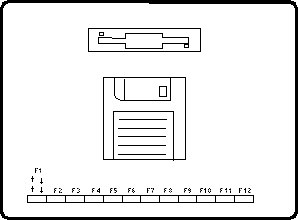
| Verify that the hard disk drive is correctly installed.
Or, verify that
the self-starting diskette is inserted correctly (with the label up and
metal-shutter end first) in the diskette drive.
If so, press F1. If both prompts
remain, have the computer serviced.
|
Error 163 appears
with the date and time window.
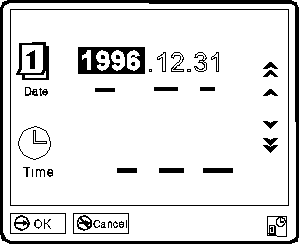
|
The date and time screen appears when neither
the date nor the time is set in the computer.
Set the date and time by typing or clicking on
the  or
or  to set the numbers;
then click on the OK button. to set the numbers;
then click on the OK button.
|
Power-on password prompt.
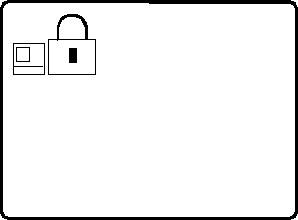
| A power-on or supervisor password was set.
To use the computer, type the correct password
and press Enter
(see "Setting a Power-On Password").
If the power-on password is not accepted,
a supervisor password
might have been set. Type the supervisor password and press Enter.
If there is still a problem, have the computer serviced.
|
Hard disk password prompt.

| A hard disk password was set.
To use the computer, type the correct password
and press Enter (see "Setting a Power-On Password").
If there is still a problem, have the computer serviced.
|
Test menu.
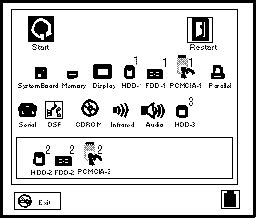
| Select the Start icon and follow the instructions
to test your system.
|
POST error prompt.
(Ref #139.)
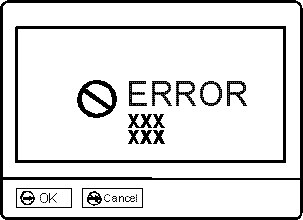
| An error was found during the POST. Press Enter; then
select Start from the Test menu to run the test.
If the test ends with an error, make a note of the error code
and have the computer serviced.
|
Error prompt.
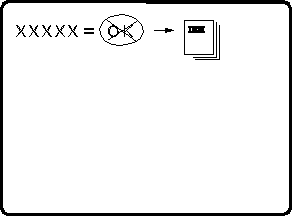
| Turn off the computer and start Easy-Setup;
then select Test to test the computer.
If the test ends with an error, make a note of the error code
and have the computer serviced.
You can start the operating system by pressing F1
instead and ignore the error.
|
DOS full-screen looks smaller.
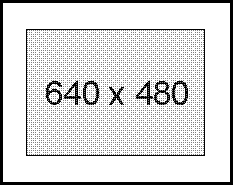
| When you use a DOS application that supports only
VGA mode (640-by-480 resolution) with your computer,
the screen image might look slightly distorted or
might appear smaller than the display size.
This is to maintain compatibility with DOS applications.
To expand the screen image to the same size as the actual screen,
start the ThinkPad Features program and
click on the Display button
( ); then
select the screen expansion function.
(However, the image may look slightly distorted.) ); then
select the screen expansion function.
(However, the image may look slightly distorted.)
|
| A panel or message that is not listed.
| Turn off the computer and start Easy-Setup;
then select Test to test the computer.
If the test ends with an error, make a note of the error code
and have the computer serviced.
If you cannot start Easy-Setup, have the computer serviced.
|
) icon.
) icon.
) or Both (
).